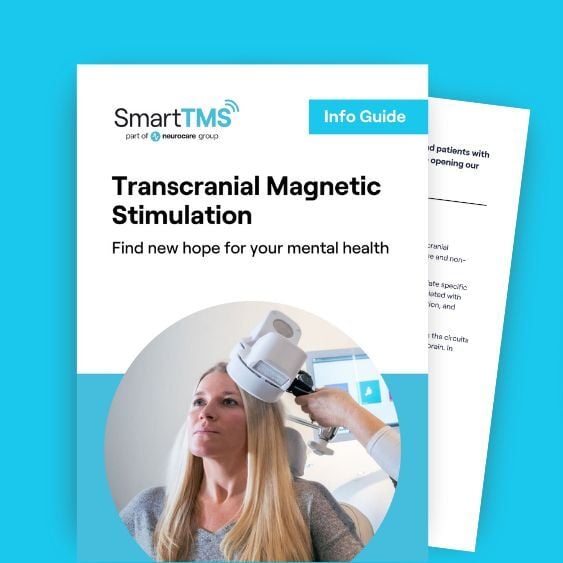Can TMS help with Alzheimer’s Disease?
February 9, 2023 - Smart TMS

What is Alzhemier’s Disease?
Alzheimer’s Disease (AD) is a progressive neurological disorder that was first identified in the early 1900s. It is the most common cause of dementia and does not just affect memory, but also affects the way someone thinks, feels, and behaves.
Symptoms of AD include
- memory loss
- disrupted thinking and reasoning
- inability in making judgements and decisions
- difficulties in planning and performing familiar tasks
- changes in language
- changes in personality and behaviour
- loss of preserved skills.
AD affects people differently, but it is known as a progressive disorder because all the symptoms will, over time, get worse. Until the person is no longer able to complete everyday tasks.
AD affects 1 in 14 people over the age of 65, 1 in 6 people over the age of 80 and 1 in 20 people under the age of 20 (reference).
Scientists are still unsure of the exact cause of AD, but studies and scans have shown that neurons are damaged and lose connection, resulting in AD symptoms. This is often due to plaques and tangles which disrupt the structure of the neurons. As the cells die, over time, the brain shrinks. Keep in mind that the damage to the brain starts long before the symptoms appear.
Unfortunately, there is no cure for AD. It is often managed with a combination of mediation for AD (e.g., acetylcholine inhibitors), and sometimes medications for the challenging behaviour that results from the conditions (e.g., antidepressants). Other forms of treatment can also be provided to aid the person in improving memory and problem-solving skills, such as cognitive stimulation therapy or cognitive rehabilitation. Additionally, recently beta-amyloid blockers have been approved to be prescribed for the early stages of AD.

Image credit Roche.com Alzheimers Disease:the value of accurate diagnosis
How can TMS help?
There has been a growing interest in repetitive transcranial magnetic stimulation (rTMS) and its efficacy in treating AD. In 2012, Nardone and colleagues reviewed a series of studies that assessed rTMS and tDCS on AD. Overall, the 3 studies that looked at the efficacy of high-frequency rTMS found significant improvements in aspects of AD, such as action naming.
A more recent double-blinded, sham-controlled, randomized controlled study (RCT) (Marra et al., 2015) comparing active versus sham TMS in 34 patients with mild cognitive impairment. In the active group, they administered high-frequency rTMS on the left dorsolateral prefrontal cortex (DLPFC). Results demonstrated a significant improvement in everyday memory in the patients who received active rTMS in comparison to those who received sham treatment. Additionally, these improvements were kept after 1 month!
A 2022 systematic review and meta-analysis looking at the therapeutic efficacy of TMS in managing AD provides a more up-to-date picture (Wei et al., 2022). Wei and colleagues systematically selected and reviewed 14 RCT and cross-section studies, which looked at a total of 513 patients with varying degrees of AD between the ages of 60 and 80 years old.
In summary, 7 of the studies administered high frequency (20Hz), 1 used low frequency (1Hz) and 6 used high frequency (10Hz). 10 of the studies targeted the DLPFC and 13 of the studies used a figure of 8 coil. The sessions varied between 5 to 54 sessions and follow-ups ranged from 1 to 10 months.
What did they find? The authors found that rTMS leads to significant improvement in cognitive function and improved performance in daily living abilities. Overall, they found that 10Hz, for 20 minutes or longer, over the left DLPFC resulted in the most effective cognitive function improvements. Researchers suggest that this is because high-frequency rTMS aims to increase cortical activity and connectivity that is otherwise lost in AD (Weiler et al., 2020)
Conclusion
Based on these recent studies, we can assume that rTMS is a safe and effective treatment to alleviate symptoms of AD. However, it is unfortunate that it is not that simple. There are a few challenges that we need to keep in mind when considering such results. For example, it is difficult to judge the degree to which observed cognitive improvement is not just a result of improvement in depressive symptoms – and not AD. Additionally, many of the studies suggest that treatment efficacy with rTMS may be dependent on the disease stage (i.e., more effective in early stages).
This is why we need properly designed, and larger trials to address unresolved issues in the use of rTMS as a therapeutical treatment in AD.
Author, Athana,
Smart TMS London Practitioner
References:
Weiler, M., Stieger, K.C., Long, J.M., & Rapp, P.R. (2020). Transcranial Magnetic Stimulation in Alzheimer’s Disease: Are we Ready? eNeuro, 7(1).
Wei Z, Fu J, Liang H, Liu M, Ye X, Zhong P (2022). The therapeutic efficacy of transcranial magnetic stimulation in managing Alzheimer’s disease: A systemic review and meta-analysis. Front Aging Neurosci.
Nardone, R., Bergmann, J., Christova, M., Caleri, F., Tezzon, F., Ladurner, G., Trinka, E., and Golaszewski, S. Effect of Transcranial Brain Stimulation for the Treatment of Alzheimer Disease: A review. International Journal of Alzheimer’s Disease, 2012.
Marra, H. L. D., Myczkowski, M. L., Memória, C. M., Arnaut, D., Ribeiro, P. L., Mansur, C. G. S., Alberto, R. L., Bellini, B. B., da Silva, A. A. F., Tortella, G., de Andrade, D. C., Teixeira, M. J., Forlenza, O. V., & Marcolin, M. A. (2015). Transcranial magnetic stimulation to address mild cognitive impairment in the elderly: A randomized controlled study. Behavioural Neurology, 2015, Article 287843.










